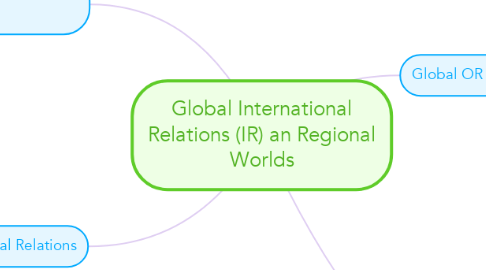
1. The international Relations of Sahibs and Munshis
1.1. Over past decades, IR schools, department, institutes and conventions
1.2. The Asiatics are capable of as high civilization and the Indias scholar knew he was superior to Asiatics.
1.2.1. The study of IR is expanding lost of excitement around the world. Distinctions between the West and the Rest blur in the materials terms.
1.3. The IR community is complicit in the marginalization of the postcolonial world in developing the discipline
2. Global International Relations
2.1. Why is there no non-western theory?
2.1.1. Non-Western as part of a broader challenge of reimagining IR as a global discipline.
2.1.1.1. Global IR stays around six dimensions
2.1.1.1.1. Pluralistic universalism
2.1.1.1.2. World history
2.1.1.1.3. Subsumes rather than supplants.
2.1.1.1.4. Integrates the study of regions
2.1.1.1.5. Eschews exceptionalism
2.1.1.1.6. Multiple forms of agency.
3. Global OR Research Agenda
3.1. Discover New Patterns, Theories, and Methods from World Histories to Challenge Current Stereotypes
3.1.1. The tendency among Western IR theories to regard centralization as aberrations, while decentralization is seen as the norm of international system is misleading.
3.2. Analyze Changes in the Distribution of Power and Ideas after 200 Plus Years of Western Dominance and its Implications for World Order
3.2.1. Is wether the emerging world order will be either a reconstituted form of American Hegemony or a reply of nineteenth and early twentieth century European multipolarity,
3.2.1.1. Multiplex world: Variety of plots, actors, producers, and directors of world politics.
3.3. Engage with Subjects and Methods that Require Deep and Substantive Integration of Disciplinary and Area Studies Knowledge
3.3.1. Global IR scholarship should rise above the false divide between areas studies approaches and IR as a discipline with its distinctive theories, methods,, and empirical terrain.
3.4. Examine How Ideas and Norms Circulate Between Global and Local Levels
3.4.1. Difussion of ideas and norms. Gives more play to the role of local actors, which may include both state and non state actors att regionals, national, and substate levels.
3.5. Investigate The Mutual Learning among Civilizations, of which there is More Historical Evidence than there is for the Clash of Civilizations
3.5.1. Explore and conceptualize the multiple and different ways in which civilizations encounters. This involves, questioning and narrow, ahistorical, strategic views of civilizations popularized.
3.6. Explore Regional Worlds in Their Full Diversity and Interconnectedness
3.6.1. Great-Power spheres of influence
3.6.2. Conflict - management
3.6.3. Expression of cultural identity and autonomy
3.6.4. Approach to suppress nationalism and prevent return to war
3.6.5. As a forum for organizing resistance to great-power intervention
3.6.6. To promote economic development through regional self-reliance and intraregional linkages
3.6.7. Fragmentation of the global liberal order into trading or economic blocs

